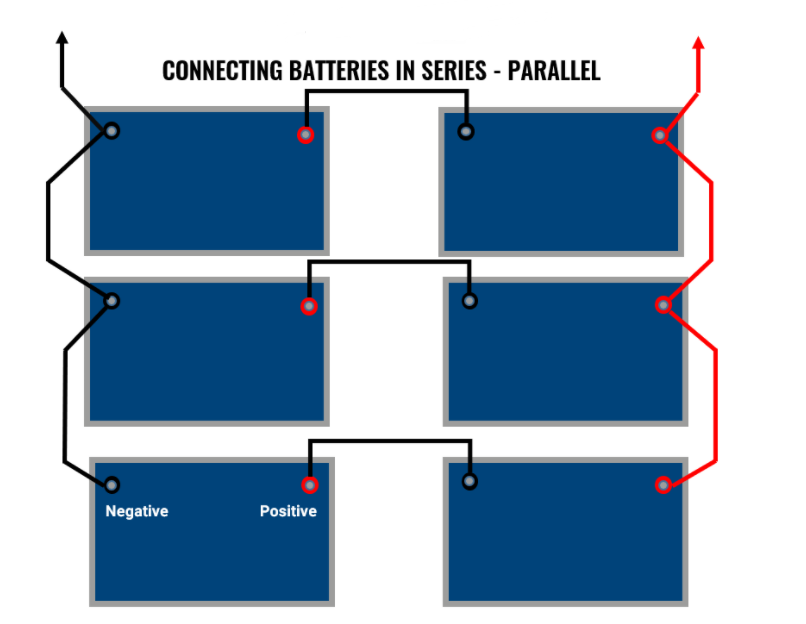If you have ever worked with batteries, you may have encountered the terms series, parallel, and series and parallel. We are often asked questions such as “what do these terms mean?”, “What is the difference between series and parallel”, “and Lithium batteries can be connected in series” and so on. If you are not familiar with lithium batteries or general lead acid batteries, this may be confusing, but hope we can help simplify it.
Let’s start from the beginning-your battery pack. Series, series, parallel, and parallel are the actions of connecting two batteries together, but why do you want to connect two or more batteries together in the first place? A battery pack is the result of connecting two or more batteries together for a single application (i.e. a sailboat). What is the effect of connecting multiple batteries together? By connecting two or more batteries in series, series, parallel, or parallel, you can increase the voltage or ampere-hour capacity, or even both; allowing higher voltage applications or power-hungry applications.
Series-connected batteries refer to connecting two or more batteries together to increase the overall voltage of the battery system. Series-connected batteries will not increase the capacity, but only increase the voltage.
For example, if you connect four 12Volt 100Ah batteries, the battery voltage is 48V and the battery capacity is 100Ah.
To configure the batteries to be connected in series, each battery must have the same voltage and rated capacity, otherwise the battery may be damaged. For example, you can connect two 6Volt 200Ah batteries in series, but you cannot connect a 6V200Ah battery to a 12V200Ah battery.
To connect a group of batteries in series, you connect the negative terminal of one battery to the positive terminal of the other battery and so on, until all batteries are connected, then connect the link/cable to the negative terminal battery of the first battery in the string Connect to your app, then connect another cable to the positive terminal of the last battery in your battery string to your app.
When charging the batteries in series, you need to use a charger that can match the battery system voltage. We recommend that you charge each battery separately to avoid battery imbalance.
All the time, sealed lead-acid batteries have been the battery of choice for long-string, high-voltage battery systems. Although lithium batteries can be configured in series, attention should be paid to BMS or PCM.

Parallel battery refers to connecting two or more batteries together to increase the ampere hour capacity. Parallel battery connection capacity will increase, but the battery voltage will remain the same.
For example, if you connect four 12V150Ah batteries, you will get a 12V600Ah battery system.
When connecting batteries in parallel, the negative electrode of one battery is connected to the negative electrode of the next battery, and so on, the positive electrode is also the same, that is, the positive electrode of one battery is connected to the positive electrode of the next battery. For example, if you need a 12V500Ah battery system, you need to five 12V100Ah batteries or two 12V250AH batteries are connected in parallel.
Parallel battery configurations help extend the duration of the battery powering the device, but due to the increase in ampere-hour capacity, they may require longer charging times than series batteries

Last but not least! There are batteries connected in series and parallel. Series-parallel connection refers to connecting a string of batteries to increase the voltage and capacity of the battery system.
If we connect two pairs of two batteries in series, and then connect these series-connected batteries in parallel, then this battery pack configuration is called battery series-parallel.
In other words, it is a series connection, not a parallel circuit, but a series-parallel circuit. Some components are connected in series, while others are complex circuits in which devices and batteries are connected in parallel or in series and parallel.
When you need to double the battery capacity or ampere hour (Ah) rating and battery voltage according to the system needs, it is good to choose the connect way in series-parallel.
For example, you can connect six 6V 100Ah batteries together to provide you with a 24V 200Ah battery. This is achieved by configuring two strings of four batteries.
You can use any number of batteries for operation, that is, to obtain different levels of voltage when the batteries are connected in series and parallel, and to increase the battery capacity in ampere hours.
The system is used for different solar panel installations and other applications.

Here are some warnings and instructions:
1. Do not short-circuit or touch the positive (+) terminal of the battery with the negative (-) terminal of the battery to avoid short circuit, damage, injury, explosion or fire.
2. Always connect batteries of the same voltage level and capacity to avoid charging problems and shorten battery life.
3. Don’t confuse (because it can be dangerous) complicated wiring and connection with battery series and parallel. Before actual implementation, be sure to perform appropriate calculations and make diagrams and diagrams of battery pack connections to ensure safety.
4. Before connecting or disconnecting the terminals, please disconnect the battery charging power source and load.
Whether you are looking for higher voltage or amp-hour capacity, it is important to understand the difference between series and parallel configurations and their impact on battery pack performance. Understanding the difference between these parallel and series configurations, you can maximize the life and overall performance of the battery.
If you need any assistance in configuring series, parallel, or series-parallel batteries, please contact one of our battery experts.